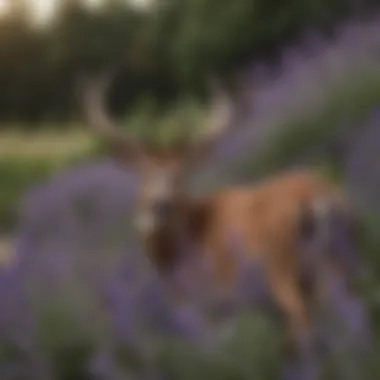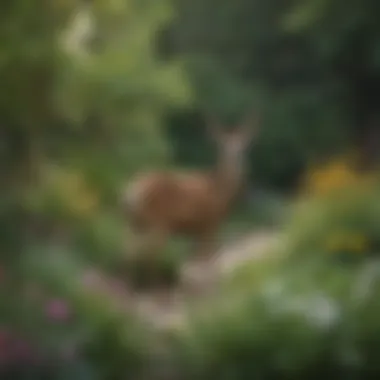Deer Resistant Perennial Flowering Plants Guide


Intro
Deer can be a constant challenge for gardeners, particularly in regions where these animals are prevalent. As they forage for food, many garden plants fall victim to their appetite. This article explores perennial flowering plants that resist deer, offering practical guidance for those looking to enhance their gardens while minimizing the risk of damage.
The selection of deer-resistant plants not only involves understanding what they are but also incorporating them in ways that align with your landscaping objectives. By selecting the right species, you can create a thriving garden that deters deer naturally. This discussion will delve into specific plant traits, cultural practices, and strategic planning for effective gardening.
Therefore, careful planning when introducing these plants improves both aesthetics and functionality. Understanding the scientific basis for deer resistance helps clarify why some plants remain unnoticed by deer. As we move through this article, the focus will encompass various aspects of plant selection, characteristics, and the broader implications of these choices.
Intro to Deer Resistant Plants
Deer resistant plants hold significant value for homeowners and gardening enthusiasts. These plants provide not only beauty but also a practical solution to a common challenge in landscaping—deer munching on garden vegetation. Understanding how to select these plants wisely can greatly enhance the success of a garden.
Deer often roam areas where food is accessible, leading to damages in carefully curated gardens. Therefore, the strategic choice of deer resistant plants can protect your landscape while ensuring it remains visually appealing. With proper planning, it's possible to create a dynamic and vibrant garden.
Understanding Deer Behavior
To effectively select deer resistant plants, one must first grasp the eating habits and preferences of deer. These animals are herbivorous, largely feeding on a wide variety of plants. Their diet usually consist of tender leaves, flowers, and shrubs. However, they tend to avoid certain plant species due to their taste or odor.
Deer are opportunistic feeders. They will graze on what is readily available. During times of food scarcity, they may become more aggressive in their search for forage, which stresses the importance of knowing what they will typically avoid. Certain characteristics—such as strong scents or bitter tastes—can deter deer effectively.
Importance of Plant Selection
The selection of the right plants is crucial for any garden, especially where deer are prevalent. Choosing plants with deer resistant qualities is essential not just for protecting horticultural investments, but also for fostering a sustainable ecosystem.
More specifically, integrating these plants into your landscape reduces the likelihood of deer creating a habit of visiting your property. Beyond aesthetics, the incorporation of deer resistant varieties can support local wildlife and promote plant health. Knowing how to select and implement these non-palatable species elevates garden design while serving a functional purpose.
Characteristics of Deer Resistant Plants
Understanding the characteristics of deer resistant plants is essential for gardeners who wish to preserve their efforts from being undermined by local wildlife. These plants possess unique traits that enable them to deter deer, making them a valuable asset in landscaping. By choosing the right species, gardeners can create an attractive garden that remains largely untouched by hungry herbivores. This section explores two main aspects: the physical attributes and growth habits of these plants, as well as the specific chemical compounds that contribute to their deterrent qualities.
Physical Attributes and Growth Habits
Deer resistant plants often exhibit certain physical attributes that make them less appealing to deer. For example, many have tough or leathery leaves. This type of foliage is generally less palatable for deer compared to softer, more tender leaves. Additionally, some species may have thorny or spiky characteristics, which act as a natural deterrent.
Height and density also play a role in how attractive a plant is to deer. Taller plants may be less likely to be chewed upon, while denser plantings can provide a defensive barrier for more vulnerable specimens. Some commonly sought-after flowering perennials, like Salvia and Yarrow, not only offer beauty and color to a garden but also fit this profile with their robust and textured foliage.
Furthermore, the growth habits of these plants should not be overlooked. Many deer resistant perennials are low maintenance and do well in various soil types. For example, Lavender thrives in sandy soil and requires excellent drainage, making it less likely to attract deer due to its arid habitat preference. Another appealing aspect is their ability to withstand periods of drought, which can be of great benefit in challenging growing conditions.


Chemical Compounds and Aromatic Qualities
Plants that can resist deer often have distinctive chemical compounds that contribute to their deterrent properties. These compounds make them less palatable or even offensive to deer. For example, many aromatic herbs, such as Catmint and Rosemary, emit strong scents that can confuse or repel deer. The aromatic oils in these plants are not only delightful to human noses but can deter animals from considering them as a food source.
These chemical properties also serve as a protective mechanism against pests and diseases, leading to an overall healthier garden. The unique scents and flavors of deer resistant plants can create a biodiverse environment that supports beneficial insects, promoting an ecosystem where both flora and fauna thrive.
A notable example of this is the Peony. Its rich fragrance, while attractive to gardeners, can be off-putting for deer when plentiful alternatives are available. The defensive chemical profile of these plants allows gardeners to maintain an appealing landscape without constant worry about deer browsing.
"Selecting the right deer resistant perennial is not just about aesthetics; it's a strategic choice that supports both your garden and local ecology."
In summary, the characteristics of deer resistant plants encompass both physical and chemical qualities that significantly reduce their appeal to deer. By understanding these traits, gardeners can make informed decisions that lead to a thriving, deer-resistant landscape.
Popular Species of Deer Resistant Perennials
Understanding popular species of deer resistant perennials is vital for gardeners who want to protect their plants while maintaining a visually appealing landscape. These plants not only deter deer but also offer an array of colors and fragrances to enhance garden beauty. Selecting the right species can lead to long-term success, minimizing both maintenance efforts and the frustration that comes from deer-related damage. Moreover, these plants adapt well to various climates, contributing to their popularity.
Lavender: The Fragrant Barrier
Lavender is well-regarded for its delightful scent and striking purple flowers. This perennial thrives in well-drained, sunny locations. Its strong fragrance acts as a natural deterrent to deer, making it a perfect choice for homeowners. Beyond its deer-resistant properties, lavender serves multiple purposes: it attracts pollinators, such as bees and butterflies, and can be harvested for culinary or aromatic uses. When planting lavender, ensure it gets enough sunlight and minimal water to avoid root rot, which can be a common issue in overly moist soils.
Catmint: Attractive and Tough
Catmint, specifically Nepeta, is a perennial plant that stands out due to its gray-green foliage and vibrant blue flowers. It has a resilient nature, flourishing in various soil conditions while being drought-resistant. Deer tend to avoid catmint, likely due to its aromatic leaves, which are not appealing to them. Additionally, this plant provides an excellent ground cover and pairs well with other perennials, offering landscape versatility. Regular trimming helps promote bushier growth and extended flowering.
Salvia: Colors and Resilience
Salvia encompasses a diverse range of species, featuring various heights and colors. It is known for its vibrant blooms which can vary from deep blue to fiery red. Salvia is not only visually appealing but is also drought-tolerant and easy to maintain. Its strong scent and woody stems are unappealing to deer, thus ensuring better plant survival. When integrating salvia into your garden, consider its growing requirements, placing it where it gets ample sunlight and proper drainage to thrive.
Peony: A Garden Staple
Peonies are cherished in many gardens for their lush, fragrant blooms. They come in a variety of colors, including pink, white, and red, adding dramatic visual impact. Peonies are generally ignored by deer, which makes them a reliable choice for those living in deer-prone areas. They require well-draining, fertile soil and benefit from being divided every few years to maintain health and vigor. By selecting the right plant type and care routine, peonies can flourish for decades, making them a favorite among antique and modern gardeners alike.
Yarrow: Low Maintenance and Hardy
Yarrow, known scientifically as Achillea, is a hardy perennial often found in wildflower gardens. With its fern-like leaves and clusters of small flowers, yarrow can handle poor soil conditions and resist drought. Its aromatic leaves deter deer while attracting beneficial insects and pollinators. An additional benefit is yarrow’s ability to thrive with minimal maintenance, making it ideal for busy gardeners. Regular deadheading will encourage prolonged flowering throughout the season, ensuring lasting beauty.
"Choosing deer resistant plants allows you to enjoy a vibrant garden without the constant worry of deer damage."
Understanding the characteristics and benefits of these popular species will empower gardeners to make informed decisions. The right selection not only brings aesthetic pleasure but also ensures the long-term health and resilience of garden spaces.


Cultivation Techniques for Success
The success of deer-resistant perennial flowering plants in any garden is closely linked to proper cultivation techniques. These methods not only promote healthy plant growth but also enhance their resilience against the pressures posed by potential deer invasions. When cultivating these plants, understanding their specific needs is essential. This section discusses critical aspects of soil requirements, watering practices, and sunlight exposure to cultivate a visually appealing and sustainable garden while minimizing deer damage.
Soil Requirements and Amendments
Soil is foundational for the growth of any plant, including deer-resistant perennials. Understanding the soil's texture, pH, and nutrient levels is important. Most perennial flowering plants thrive in well-draining soil rich in organic matter. It's advisable to conduct soil tests to determine nutrient deficiencies or pH imbalances. Amending the soil with compost or well-rotted manure can significantly improve its fertility and structure, aiding moisture retention and nutrient availability. Furthermore, adding mulch around the plants can help regulate soil temperature and moisture levels, creating an ideal environment for growth.
Proper Watering Practices
Water requirements differ widely among perennial flowering plants. While establishing new plants, it is critical to provide consistent watering. This ensures that the roots take hold properly. Deep watering is preferred over shallow watering, as it encourages deeper root growth. During dry spells, your plants may need more frequent watering, but be cautious of over-watering, which can lead to root rot. Establishing a scheduled watering routine can help manage moisture levels effectively. Collecting rainwater can also be a sustainable practice that benefits both the plants and the environment.
Sunlight Needs and Positioning
Sunlight is another critical factor influencing the growth of deer-resistant plants. Most perennial flowering plants require full to partial sunlight, typically at least six to eight hours of direct sunlight daily. Strategic placement of these plants in your garden can help them thrive. Assess the sunlight exposure in different garden areas when planning your layout to avoid under-performance. Consider using taller plants to provide some shade to those requiring less light. Just remember, positioning can be adjusted to meet specific light needs, ensuring every plant gets its essential dose of sunlight.
"Healthy plants not only survive but thrive when their basic cultivation needs are met. Prioritize soil, water, and sunlight for sustainable growth."
Taking into consideration these cultivation techniques will create the necessary conditions for deer-resistant perennials to flourish. This enhances the likelihood of a successful garden, allowing it to withstand the impact of deer while remaining visually pleasing to the human eye.
Creating a Deer Resistant Garden
Creating a garden that is resistant to deer is essential for homeowners who wish to maintain the beauty and integrity of their outdoor spaces. Deer are known to consume a wide variety of plants, often leading to frustration and disappointment when carefully chosen flowers and shrubs disappear overnight. By cultivating a deer resistant garden, you not only minimize damage caused by these animals but also promote a sustainable and visually appealing environment. The focus here is on strategic planning that integrates plant selection, design principles, and relationships among different plants.
Design Principles for Aesthetic Appeal
When designing a deer resistant garden, it is important to consider aesthetics alongside functionality. A well-planned garden can be both beautiful and practical. Color, texture, and structure should be carefully selected to create a harmonious visual experience. Use a mix of perennial flowering plants that provide various bloom times and colors, ensuring that there is always something in flower. Group plants together based on their heights and forms, creating layers and depth within your garden.
Consider incorporating elements such as pathways and garden beds that guide the eye and encourage exploration. Vertical structures, like trellises or arches, can also be effective for creating visual interest while supporting climbing plants that deter deer, such as certain types of roses. The key is to create a landscape that is inviting not just for people but supports the ecosystem and discourages deer grazing.
Integrating Perennials with Other Plants
Integrating deer resistant perennials with other plant types enhances the overall resilience of the garden. It is crucial to have a diverse planting strategy. This approach makes it harder for deer to find their favorite snacks among the variety of plants. Pairing deer resistant perennials with shrubs, bulbs, and ground covers can lead to a more dynamic landscape.
Some beneficial combinations include:
- Shrubs like boxwood and holly, which can serve as natural borders and add structure.
- Bulbs such as daffodils, which are generally avoided by deer, can add early spring color.
- Ground covers that thrive in shaded areas can fill gaps in the garden and deter deer due to their unpalatability.


Utilizing Companion Planting Strategies
Companion planting is a technique that can enhance the efficacy of a deer resistant garden. By planting different species close together, you can maximize their benefits to one another while making the garden less attractive to deer. Certain plants can deter pests, attract beneficial insects, or even enhance the flavors and growth of nearby plants.
For example, planting lavender near vegetables can not only keep deer at bay but also attract pollinators. Similarly, interspersing potent herbs like rosemary and sage throughout the garden can create aromatic barriers that many animals find unappealing.
Additionally, the strategic placement of taller plants can offer shade and create microclimates. Consider placing taller deer resistant varieties at the back of the bed, allowing shorter companions to thrive in the sunlit front.
"A thoughtfully designed deer resistant garden not only enhances beauty but serves as a long-term investment in your landscape."
Challenges of Maintaining Deer Resistant Plants
Maintaining deer resistant plants brings its own unique set of challenges. Choosing the right plants is only the beginning. Gardeners must also manage various factors that contribute to the health and longevity of these plants. A successful garden depends on understanding these complexities and developing effective strategies to keep plants thriving while minimizing deer interactions. This section focuses on critical elements such as pest and disease management, along with seasonal care requirements that can significantly impact the success of a deer resistant garden.
Pest and Disease Management
Pests and diseases can threaten the health of any garden, including those filled with deer resistant varieties. Although these plants are less attractive to deer, they are not immune to insects and diseases. Regular monitoring is vital. Gardeners should look for signs such as discolored leaves, holes in foliage, or unusual growth patterns.
Common pests include aphids, spider mites, and whiteflies, which may appear even on the hardiest of perennials. Implementing various management techniques can help mitigate these issues:
- Cultural Practices: Rotate crops, clean up debris, and maintain healthy soil. Keep plants strong to withstand pest pressure.
- Physical Barriers: Use row covers or nets to protect plants, especially young ones, from harmful insects.
- Natural Predators: Encourage beneficial insects like ladybugs or lacewings, which help keep pest populations in check.
Regular assessments can identify problems before they escalate. A proactive approach, combined with integrated pest management strategies, ensures that deer resistant plants remain healthy and vibrant while also deterring unwanted visitors.
Seasonal Care Requirements
Seasons play a significant role in how deer resistant plants thrive. Each season brings its own set of cares and considerations that are crucial for their success. Here are key seasonal strategies:
- Spring: This is a crucial time for growth. Begin by cleaning up gardens, removing any dead material, and applying a balanced fertilizer. Spring is also an excellent time to perform a thorough inspection for signs of pests and diseases.
- Summer: During hot months, these plants may require additional watering. Mulching helps conserve moisture and control weeds. Keep an eye out for any pest activity, as populations can grow rapidly during this time.
- Fall: As growth slows, it is important to prepare plants for the winter. Cut back any dead growth and apply mulch to protect roots from freezing temperatures. Fall is also an ideal time to assess the overall health of the garden and plan for any adjustments needed in the coming year.
- Winter: While many perennials go dormant, protection is still key. In colder climates, consider providing additional insulation through mulch to prevent root damage.
Regular seasonal care supports the integrity of deer resistant plants. A well-maintained garden can flourish despite deer activity, making it essential to adapt to seasonal demands effectively.
Finale
Choosing deer resistant perennial flowering plants is more than just a strategy to protect one’s garden. The decision impacts not only the visual aesthetics of the outdoor space but also the long-term health of the plant ecosystem. Emphasizing specific elements, it is essential to understand the significance of thoughtful plant selection.
By selecting appropriate varieties, homeowners can reduce maintenance efforts significantly. These plants are specifically adapted to withstand grazing, thus allowing for a more resilient garden. Furthermore, as these perennials mature, they contribute to a stable garden environment, enhancing biodiversity by attracting beneficial insects and pollinators.
In addition, there is a clear economic benefit to consider. Investing in deer resistant species minimizes the need for costly protective measures, such as fences or repellents, which can be expensive and labor-intensive.
When engaging with this topic, individuals must keep in mind their regional climate and soil conditions, ensuring the chosen varieties can thrive. This consideration leads to healthier plants that require less intervention over time.
"The long-lasting beauty of a garden depends not just on the flowers it contains, but also on their ability to adapt and flourish in a challenging environment."
Ultimately, understanding the long-term benefits of selecting wisely opens the door to creating a productive, aesthetically pleasing, and hassle-free outdoor space. This not only satisfies the gardener’s vision but also respects the ecological balance needed in a shared outdoor environment.



